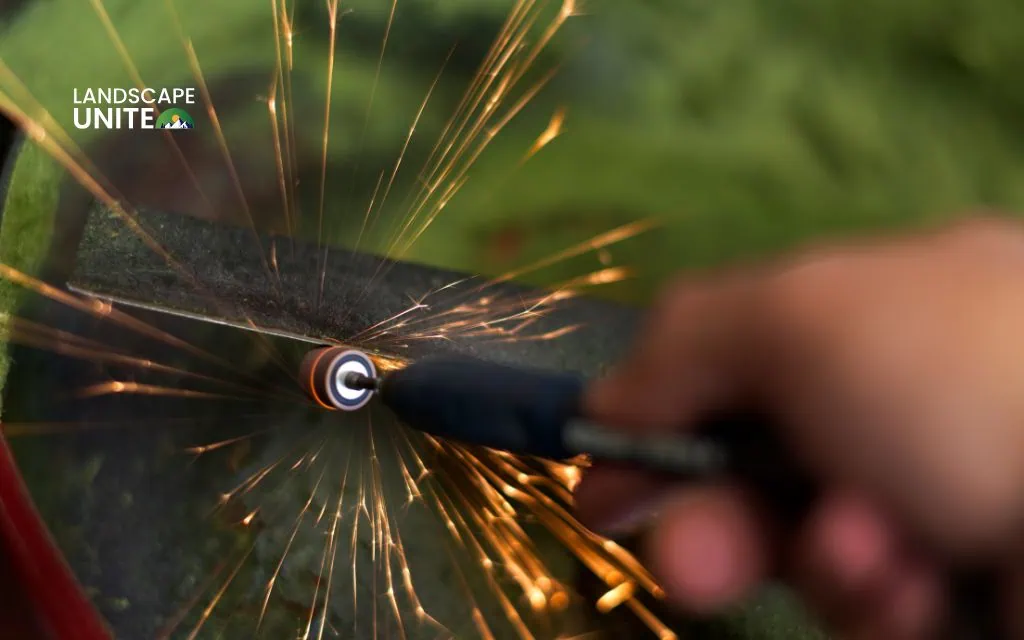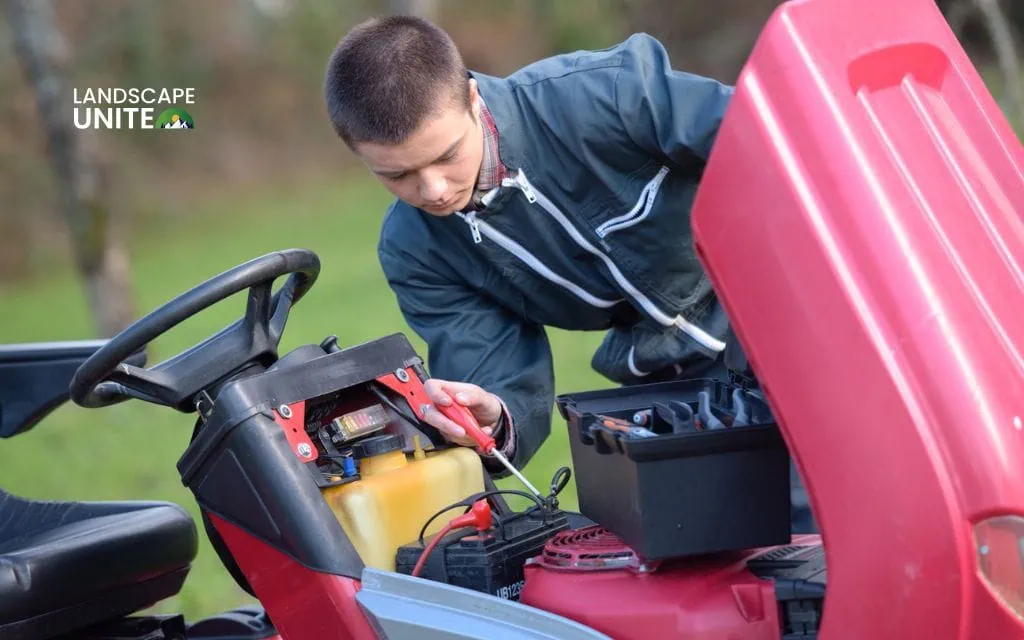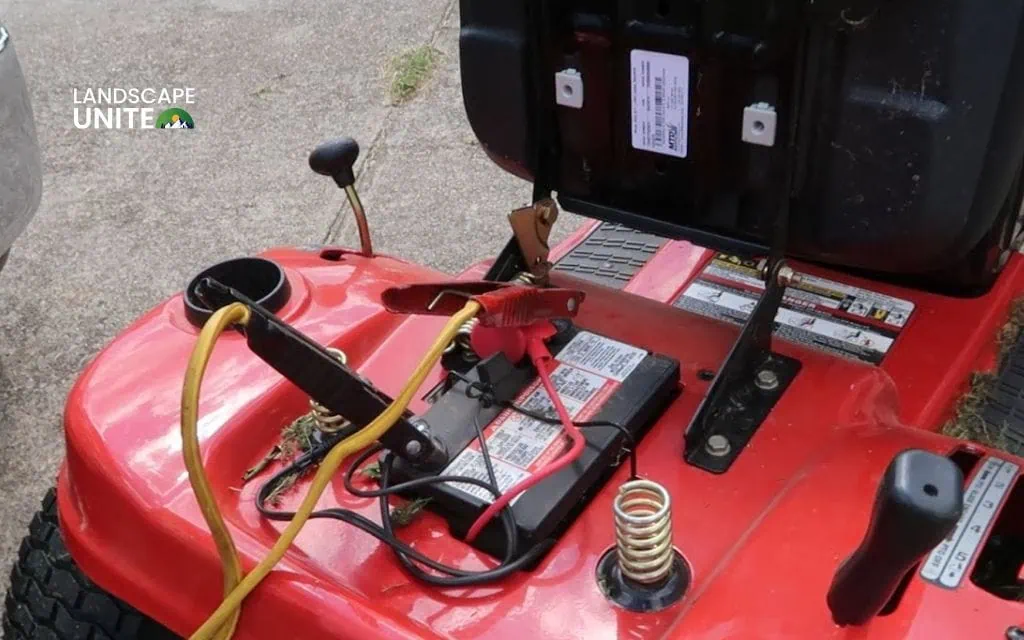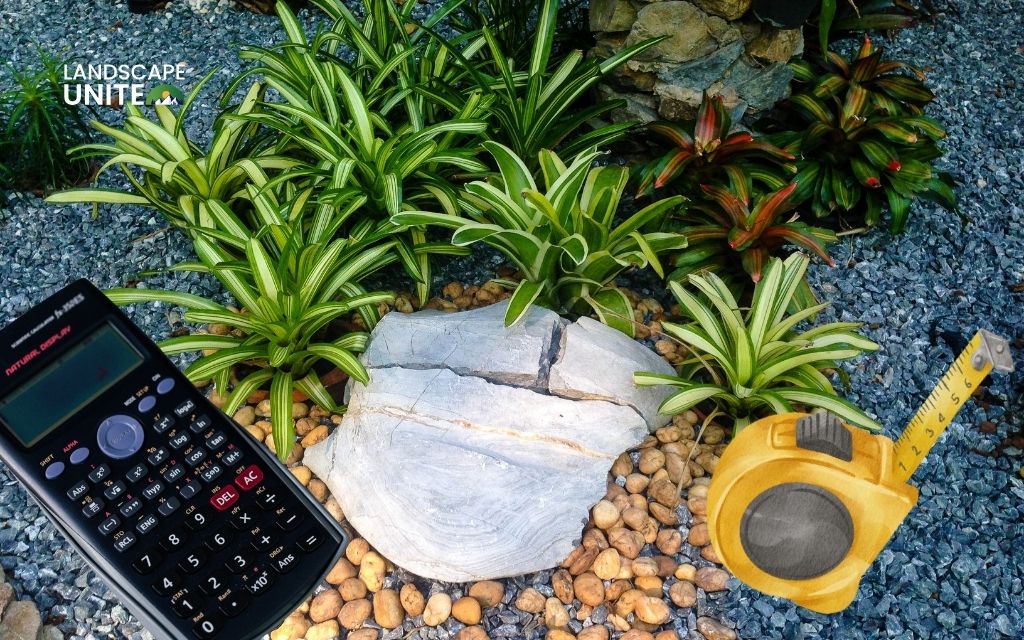Finding the answer for question “Can you jump a lawn mower with a car battery?”. Yes, you can safely jump a lawn mower with a car battery, but only if both are 12-volt systems and you follow proper safety procedures. This is especially important for Colorado residents dealing with extreme temperature fluctuations that can drain lawn mower batteries faster than in other climates.
Understanding the correct jump-starting process can save you time and prevent costly damage to your equipment. When your lawn mower won’t start jump battery issues are often the culprit, particularly during Colorado’s harsh winters.
What you’ll learn in this guide:
- Battery compatibility – How to identify 12V vs 6V systems and ensure safe connections
- Colorado-specific challenges – High altitude effects and extreme weather impacts on battery performance
- Step-by-step procedures – Safe jump starting techniques with proper cable connections
- Safety precautions – Essential equipment and when NOT to attempt jump starting
- Troubleshooting tips – What to do when jump starting doesn’t work
- Maintenance strategies – Seasonal care specific to Colorado’s harsh climate
- Professional alternatives – When to contact local repair services
By the end, you’ll know exactly how to jump start a riding lawn mower with a car battery and when to seek professional help from trusted Colorado service providers.
Understanding lawn mower battery systems

12v vs 6v battery identification
Most modern riding mowers use 12-volt lead-acid batteries, making them compatible for jump starting with car batteries. However, some older lawn mowers use 6-volt batteries that cannot be safely jump-started with 12-volt car batteries. The voltage mismatch can damage your mower’s electrical system permanently.
To identify your battery type, check the label on top of the battery or consult your owner’s manual. The voltage is usually clearly marked. If you’re unsure whether you can jump start a riding lawn mower with a car battery, contact a professional before attempting the procedure.
Never attempt to jump a 6V system with a 12V car battery. This voltage incompatibility can cause expensive damage to your mower’s charging system and electrical components.
How cold weather affects battery capacity
Colorado’s extreme temperature variations can reduce battery capacity by up to 50% in winter. When temperatures drop below freezing, the chemical reactions inside batteries slow down dramatically. This is why many Colorado residents find themselves asking “is it safe to jump lawn mower battery with car” during spring startup.
Battery terminal cleaning becomes especially important in Colorado’s climate. Road salt and moisture from snow can accelerate corrosion on battery terminals, reducing electrical connection quality. Clean terminals ensure better conductivity when you need to jump start lawn mower battery under seat configurations.
Cold weather battery issues are one of the most common reasons for dead battery troubleshooting in Colorado. Planning ahead with proper winter storage helps minimize these problems.
Safety precautions before jump starting
Essential safety equipment checklist
Before attempting any jump starting procedure, gather these essential items:
| Equipment | Purpose | Minimum Rating |
| Heavy-duty jumper cables | Power transfer between batteries | 200 amp capacity |
| Safety glasses | Protection from sparks | ANSI Z87.1 rated |
| Work gloves | Hand protection during handling | Insulated rubber |
| Wire brush | Terminal cleaning | Steel bristle |
| Multimeter | Voltage testing | 12V DC capable |
Quality jumper cables safety depends on proper gauge wire. Use cables rated for at least 200 amps to handle the electrical load safely. Cheap cables can overheat and create safety hazards.
Never attempt jump starting without proper safety equipment. The electrical currents involved can cause serious injury if proper precautions aren’t followed.
Voltage compatibility requirements
Both your car battery and lawn mower battery must be 12-volt systems for safe jump starting. This voltage matching is critical for preventing electrical system damage. Most riding mower electrical problems stem from improper voltage connections.
Check both battery labels before connecting any cables. The voltage should be clearly marked on both batteries. When in doubt, consult your equipment manuals or contact a professional for guidance.
Attempting to jump start mismatched voltages can damage expensive electronic components in modern lawn mowers. This type of damage often isn’t covered under warranty.
When NOT to attempt jump starting
Never attempt jump starting if you notice any of these conditions:
- Cracked or leaking battery case
- Corroded terminals that cannot be cleaned
- Frozen battery (common in Colorado winters)
- Strong sulfur smell from either battery
- Visible damage to jumper cables
If your battery appears frozen, allow it to thaw completely at room temperature before attempting to jump start. Frozen batteries can crack internally and become dangerous.
Professional lawn equipment repair services can safely handle these situations. Don’t risk personal injury or equipment damage by attempting unsafe jump starting procedures.
Step-by-step jump starting process

1. Preparing your equipment
Start by positioning your car close enough to the lawn mower so jumper cables can reach both batteries comfortably. Turn off your car engine completely. Running the car engine during jump starting can damage the mower’s charging system due to voltage spikes.
Clean both battery terminals with a wire brush to ensure good electrical contact. Remove any white, chalky corrosion that may have accumulated. This step is especially important in Colorado’s climate where corrosion builds up quickly.
Ensure both vehicles are on level ground and engage parking brakes. Remove any jewelry that might contact battery terminals accidentally.
2. Proper cable connection order
Follow this exact sequence when connecting jumper cables:
- Connect red positive cable to the dead mower battery positive terminal
- Connect other red positive cable end to car battery positive terminal
- Connect black negative cable to car battery negative terminal
- Connect final black negative cable to unpainted metal ground on mower frame
Never connect the final negative cable directly to the dead battery’s negative terminal. This creates spark risk near the battery where hydrogen gas may be present.
This connection order minimizes spark risk and provides the safest electrical path for jump starting. Following proper procedures prevents damage to sensitive electronic components.
3. Safe disconnection procedures
After successfully starting your mower, follow reverse order for disconnection:
- Remove ground cable from mower frame first
- Remove negative cable from car battery
- Remove positive cable from car battery
- Remove positive cable from mower battery last
Allow the mower to run for at least 15 minutes after jump starting to recharge the battery partially. This helps ensure the mower will start again later without immediate jump starting.
Keep jumper cables organized and inspect them after each use for damage. Proper cable maintenance ensures safety for future jump starting needs.
Need more guides about lawn mowers? Discover more in these blogs:
Troubleshooting common issues
When jump starting doesn’t work
If your mower still won’t start after proper jump starting, consider these possibilities:
- Battery has failed completely and needs replacement
- Starter motor problems unrelated to battery
- Fuel system issues preventing engine start
- Safety switches preventing startup
- Corroded electrical connections beyond the battery
Don’t repeatedly attempt jump starting if the first attempt fails. This can overheat cables and damage electrical systems. Instead, investigate other potential causes or contact professional service.
Sometimes what appears to be a dead battery issue is actually a fuel or ignition problem. Professional small engine repair technicians can diagnose these issues quickly.
Signs your battery needs replacement
Watch for these warning signs that indicate lawn mower battery replacement is necessary:
| Warning Sign | What It Means | Action Needed |
| Won’t hold charge overnight | Internal damage to cells | Replace immediately |
| Swollen or cracked case | Physical damage from freezing | Replace immediately |
| White, powdery corrosion | Acid leakage or overcharging | Clean first, then replace |
| Battery age 3-4+ years | Normal wear in Colorado climate | Plan replacement |
| Requires frequent jump starting | Reduced capacity | Replace within 30 days |
Colorado’s harsh climate typically shortens battery life compared to milder climates. Planning for more frequent battery replacement saves time and frustration during mowing season.
A battery that requires jump starting more than twice per season usually needs replacement. Continuing to jump start a failing battery can damage your mower’s charging system.
Professional service options
Colorado offers several professional options for lawn equipment service:
- Mobile small engine repair services are particularly popular due to Colorado’s outdoor lifestyle. These services come to your location and can handle battery replacement, electrical troubleshooting, and other repairs on-site.
- Authorized dealer networks for major brands like John Deere, Craftsman, Cub Cadet, Husqvarna, and Troy-Bilt provide factory-trained technicians and genuine parts.
- Local small engine shops often provide more personalized service and competitive pricing for battery-related repairs.
Alternative solutions
Battery chargers vs jump starting
While jump starting provides immediate results, battery chargers offer better long-term battery health. A quality 12V battery charger can fully restore battery capacity without the stress of jump starting.
Trickle chargers are especially valuable for Colorado residents who store equipment during winter months. These low-amperage chargers maintain battery charge without overcharging damage.
Smart chargers with automatic shutoff prevent overcharging and extend battery life. This investment pays for itself through longer battery life and fewer jump starting emergencies.
Portable jump starters for lawn equipment
Portable jump starters designed for lawn equipment provide convenient alternatives to car battery jump starting. These compact units store easily in garages and eliminate the need to position vehicles near equipment.
Look for units specifically rated for 12V lawn equipment. Automotive jump starters may provide too much power for smaller lawn mower electrical systems.
Portable units work especially well for lawn mower battery under seat configurations where access is limited. They eliminate the awkward cable routing required with car battery connections.
Emergency starting methods
If jump starting fails and no other options are available, consider these emergency approaches:
- Push starting works for some manual transmission riding mowers, though this method has limited success and potential safety risks.
- Battery swapping from another piece of 12V equipment can provide temporary solution until proper replacement.
- Professional mobile service often provides same-day battery replacement and can handle emergency calls during peak mowing season.
Maintenance tips that usable for us

Winter storage best practices
Colorado’s harsh winters require specific storage procedures to prevent battery damage:
- Remove batteries from equipment when possible and store indoors at temperatures above 32°F. Basement storage works well if temperatures remain stable.
- Apply a thin coat of petroleum jelly to terminals before storage to prevent corrosion. This simple step prevents many spring startup problems.
- Use a battery tender or trickle charger throughout winter months. These devices prevent sulfation damage that occurs when batteries sit discharged for extended periods.
Terminal cleaning and corrosion prevention
Colorado’s road salt and moisture create ideal conditions for battery terminal corrosion. Regular cleaning prevents electrical connection problems:
- Use a mixture of baking soda and water to neutralize acid corrosion. A old toothbrush works well for scrubbing terminals clean.
- Apply dielectric grease or petroleum jelly to clean terminals to prevent future corrosion. This protective coating repels moisture and salt.
- Inspect terminals monthly during active season and before storage. Catching corrosion early prevents major cleaning jobs later.
Seasonal battery testing schedule
Develop a regular testing routine using a basic multimeter:
| Test Period | Voltage Reading | Battery Condition | Action Required |
| 12.6-12.8V | Fully charged | Good condition | Continue normal use |
| 12.4-12.5V | Partially discharged | Needs charging | Charge before use |
| 12.0-12.3V | Significantly discharged | Poor condition | Charge immediately |
| Below 12.0V | Deep discharge | Critical condition | Professional service |
Testing Schedule:
- Early spring: Test voltage before first use of season
- Mid-season: Check voltage monthly during heavy use periods
- Fall preparation: Test capacity before winter storage
- Winter maintenance: Check stored battery voltage every 2-3 months
Document test results to track battery condition over time. This helps predict when replacement will be necessary.
FAQs about the question ‘can you jump a lawn mower with a car battery?’
Can I jump a 6V lawn mower battery with a 12V car battery?
No, never attempt this. The voltage difference will damage your mower’s electrical system permanently. Contact Landscape Unite for guidance on proper 6V battery service options.
Should I keep my car running while jump starting my mower?
No, always turn off your car engine before connecting jumper cables. Running engines can create voltage spikes that damage sensitive mower electronics.
How long should I let the mower run after jump starting?
Run the mower for at least 15 minutes to partially recharge the battery. This helps ensure it will start again without immediate jump starting.
What should I do if my mower still won’t start after jumping?
Stop attempting to jump start and investigate other causes like fuel problems, safety switches, or complete battery failure. Contact professional service if needed.
Are there any risks to my car’s electrical system when jump starting a mower?
Minimal risk exists when proper procedures are followed with the car engine off. Modern cars have protected electrical systems that handle standard jump starting well.
When to contact professionals
Professional service becomes necessary when DIY approaches fail or safety concerns arise. Local Denver area repair services specialize in lawn equipment and understand Colorado’s unique climate challenges.
Mobile small engine repair options provide convenient at-home service for busy homeowners. These services often carry common batteries and can complete repairs during the service call.
Consider professional help for warranty considerations on newer equipment. Improper jump starting procedures can void manufacturer warranties on expensive riding mowers.
Take action for better lawn care
Create a seasonal maintenance schedule that includes regular battery testing and terminal cleaning. Can you jump a lawn mower with a car battery? This proactive approach prevents most jump starting emergencies and extends equipment life.
Invest in proper battery maintenance tools including a quality multimeter and battery charger. These tools pay for themselves through improved reliability and longer battery life.
Keep detailed records of battery performance and maintenance activities. This information helps predict replacement timing and can be valuable for warranty claims.
About Landscape Unite
Landscape Unite is your trusted resource for gardening and landscape advice, helping Colorado residents maintain beautiful outdoor spaces despite challenging climate conditions. Our expert team understands the unique requirements of high-altitude gardening and lawn care.
We provide practical, tested advice specifically tailored to Colorado’s climate challenges. From battery maintenance to seasonal lawn care, our guides address the real-world problems Colorado residents face.
Ready to master your lawn care challenges? Follow Landscape Unite’s blogs for more expert lawn care tips and discover our comprehensive collection of US-specific gardening guides on our blog. Our team is ready to help you tackle any lawn care question, from equipment troubleshooting to seasonal maintenance planning.


